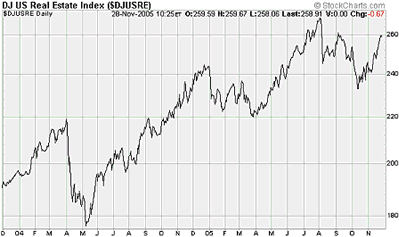| Home | About Us | Resources | Archive | Free Reports | Market Window |
Why Hold Cash? Do This Instead...By
Tuesday, November 29, 2005
Right now, my online broker Charles Schwab will pay me 3.5% interest on my cash. That’s fine. But you can do much better... Today, I’ll show you how to earn 6% annualized interest on your safe money... with the potential to earn much more than that... between now and August 4th of next year. It is a too-good-to-be-true deal, and it’s really only accessible to individual investors like you. Let me explain... FIRST UP: 6% ON YOUR CASH Let’s look at a simple math example of six percent annualized interest... To earn an annualized 6% interest between now and August 4, 2006, you’d pay $9.61 today, and receive $10 at the end. That’s how the math works. And that’s exactly what we’re going to do... Today I’ll show you two super safe investments that mature on August 4, 2006 at $10 a share. Both of them closed Friday at $9.60. If you know nothing else about these investments, know that if you buy at $9.60 today and hold until August of next year, you’ll have earned 6% annualized interest, handily beating the 3.5% on your cash that your bank account is paying you. Let’s keep going here... NEXT UP: THE UPSIDE KICKEROkay, so we know we can buy at $9.60 now and have $10 deposited in our account in August of next year. That’s all well and good. But it’s possible we could do much better... Here’s what needs to happen: If U.S. stocks or Japanese stocks can rise in excess of 20% between now and August 2006, then we can actually make more money than the 6%. Specifically, in the U.S., if the S&P 500 Index can rise above roughly 1,550 (it’s around 1,260 right now), then we get to keep all the gains above that level on a one-for-one percentage basis. If the S&P 500 rises by 10% above 1,550, then we’ll get an extra 10% back at maturity. If the S&P 500 rises by 20% above 1,550, then we’ll get an extra 20% back at maturity, and so on. In the case of Japan, the number is about 17,777 for the Nikkei Index... meaning that if Japanese stocks can reach that level, then we get to participate in the percentage gains above that level on a one-for-one basis. It sounds complicated, but it’s good stuff.
WHEN YOU PUT IT TOGETHER, YOU CAN’T BEAT IT The two stocks are MPF and NKM. MPF is a “bet” on the S&P 500 that Merrill Lynch promises will be worth at minimum $10 a share on August 4, 2006. NKM is a “bet” on Japan’s Nikkei Index with the same promise from Merrill. Both closed on Friday at $9.60. The $10 per share deposited in your account in August at minimum is rock solid, backed by Merrill Lynch. The potential for more profits is a bit of a long shot... It requires either the S&P 500 or the Nikkei to rise by more than 20% between now and August before the potential for more than $10 kicks in. It’s a bit of a long shot, but it is real. If you pay $9.60, your rate of interest between now and maturity will be 6%. If you pay $9.70, your rate of interest will be closer to 5%. For cash that you don’t need to touch between now and August of 2006, buy these two stocks with a limit order of $9.70 or less. You’ll beat the return on your bank account, AND have a potential upside kicker if Japanese stocks continue to soar, for example. It’s really a no-brainer. The best part is, these investments are small – less than $100 million in market value each. Big institutional investors like hedge funds can’t buy them. They’re just for individual investors like you and me. Let’s take advantage of ‘em! Good investing, Steve Market NotesCHARTING THE REAL ESTATE BUBBLE After spending August and September in a sharp decline, the Dow Jones Real Estate Index (DJUSRE) has spent the last month making a run at its all-time highs. The right side of this two-year chart shows the new rally:
Depending on your view of U.S. real estate, this rally may be the perfect entry point for a bet against U.S. real estate. You can learn about Steve’s favorite way play this situation in the November issue of True Wealth. |
Recent Articles
|


